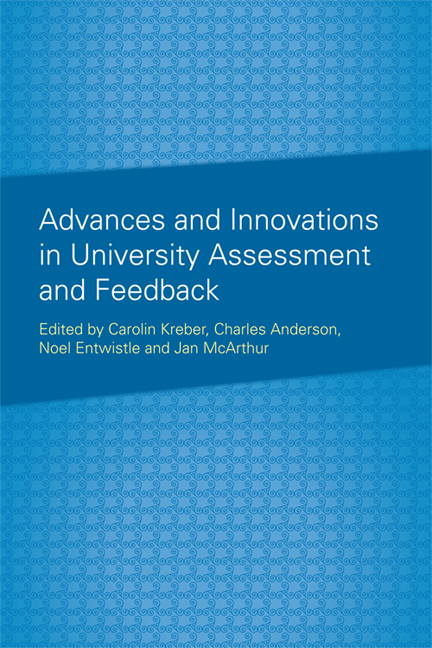Book contents
- Frontmatter
- Contents
- List of Tables and Figures
- Acknowledgements
- Foreword
- Introduction
- Part A Changing Perspectives on the Nature and Purposes of Assessment
- Part B Students' Perceptions of Assessment and Feedback
- Part C Reconceptualising Important Facets of Assessment
- Part D Innovations in Assessment Practices
- 10 Guiding Principles for Peer Review: Unlocking Learners' Evaluative Skills
- 11 Disruptions and Dialogues: Supporting Collaborative Connoisseurship in Digital Environments
- 12 Understanding Students' Experiences of Being Assessed: The Interplay between Prior Guidance, Engaging with Assessments and Receiving Feedback
- Notes on the Contributors
- Index
11 - Disruptions and Dialogues: Supporting Collaborative Connoisseurship in Digital Environments
from Part D - Innovations in Assessment Practices
Published online by Cambridge University Press: 05 August 2016
- Frontmatter
- Contents
- List of Tables and Figures
- Acknowledgements
- Foreword
- Introduction
- Part A Changing Perspectives on the Nature and Purposes of Assessment
- Part B Students' Perceptions of Assessment and Feedback
- Part C Reconceptualising Important Facets of Assessment
- Part D Innovations in Assessment Practices
- 10 Guiding Principles for Peer Review: Unlocking Learners' Evaluative Skills
- 11 Disruptions and Dialogues: Supporting Collaborative Connoisseurship in Digital Environments
- 12 Understanding Students' Experiences of Being Assessed: The Interplay between Prior Guidance, Engaging with Assessments and Receiving Feedback
- Notes on the Contributors
- Index
Summary
Introduction
Over the last decade, higher education has grappled with the integration of digital environments into assessment and feedback processes. Tools such as blogs and wikis open up new ways for individuals to work with content and with each other. This technological development has coincided with a turn towards learner-centredness, with an increasing emphasis on the co-constructed nature of meaning-making and the value of peer feedback (Hounsell et al. 2008), peer review practices (Nicol, this volume), a greater emphasis on self-regulation (Gibbs and Simpson 2004) and an emerging appetite for student involvement in assessment design (Nicol and Macfarlane- Dick 2006; Carless 2007). As a result, educators have been prompted to reflect on the nature, purpose and appropriateness of educational practices and to consider shifting the balance from assessment of learning to assessment for learning, as advocated by Hounsell, Xu, and Tai (2007a, 2007b).
Multimodal assessments can be particularly disruptive to past assumptions about the nature of assessment, since to construct or advance an argument they require meaning to be created between multiple modes of communication (such as image, text and animation) and between creator and audience (Sorapure et al. 2005). The student must guide the reader to piece together different components in such a way that each not only complements, but is dependent on, the others – a skill that lies outside traditional academic literacy (Archer 2010; Goodfellow and Lea 2007).
Tutors and students generally have a somewhat vague grasp of what represents academic quality within emerging multimodal practices or how to produce a multimodal product that conforms to assessment criteria and other requirements (for example, word count) as they are traditionally understood (Goodfellow and Lea 2005; Bayne and Ross 2013). This lack of clarity results in many students opting for more traditional assessment forms, rather than embracing new media as a novel way of forming and articulating arguments. When used, multimodalities are often treated in less risky ways – for instance, as platforms for the presentation of linear, essay-like work (Hemmi, Bayne, and Land 2009; Swan, Shen, and Hiltz 2006).
In the Manifesto for Teaching Online, Ross et al. (2011) claim that ‘assessment is a creative crisis as much as it is a statement of knowledge’.
- Type
- Chapter
- Information
- Advances and Innovations in University Assessment and Feedback , pp. 225 - 245Publisher: Edinburgh University PressPrint publication year: 2014



